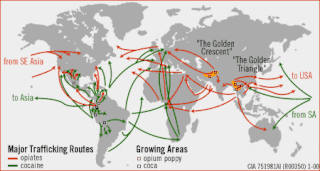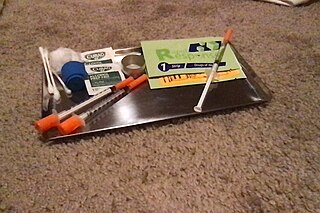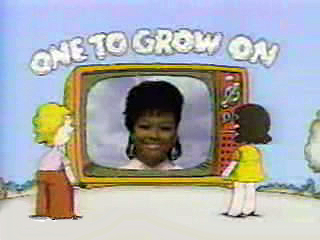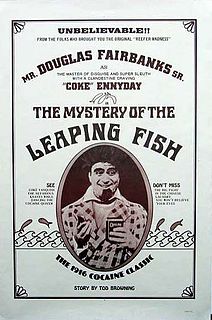Related Research Articles

Cocaine is a stimulant drug obtained from the leaves of two Coca species native to South America, Erythroxylum coca and Erythroxylum novogranatense. After extraction from coca leaves and further processing into cocaine hydrochloride, the drug may be snorted, heated until sublimated and then inhaled, or dissolved and injected into a vein. Cocaine stimulates the reward pathway in the brain. Mental effects may include an intense feeling of happiness, sexual arousal, loss of contact with reality, or agitation. Physical effects may include a fast heart rate, sweating, and dilated pupils. High doses can result in high blood pressure or high body temperature. Effects begin within seconds to minutes of use and last between five and ninety minutes. As cocaine also has numbing and blood vessel constriction properties, it is occasionally used during surgery on the throat or inside of the nose to control pain, bleeding, and vocal cord spasm.

Recreational drug use indicates the use of one or more psychoactive drugs to induce an altered state of consciousness either for pleasure or for some other casual purpose or pastime by modifying the perceptions, feelings, and emotions of the user. When a psychoactive drug enters the user's body, it induces an intoxicating effect. Generally, recreational drugs are divided into three categories: depressants ; stimulants ; and hallucinogens.

Pemberton's French Wine Coca was a coca wine created by the druggist John Pemberton, the inventor of Coca-Cola. It was an alcoholic beverage, mixed with coca, kola nut, and damiana. The original recipe contained the ingredient cocaethylene, which was removed, just like the alcohol had before it, in 1899 because of a social stigma surrounding the rampant use of cocaine at the time.

Club drugs, also called rave drugs or party drugs, are a loosely defined category of recreational drugs which are associated with discothèques in the 1970s and nightclubs, dance clubs, electronic dance music (EDM) parties, and raves in the 1980s to today. Unlike many other categories, such as opiates and benzodiazepines, which are established according to pharmaceutical or chemical properties, club drugs are a "category of convenience", in which drugs are included due to the locations they are consumed and/or where the user goes while under the influence of the drugs. Club drugs are generally used by adolescents and young adults. This group of drugs is also called "designer drugs", as most are synthesized in a chemical lab rather than being sourced from plants or opiates.

The illegal drug trade or drug trafficking is a global black market dedicated to the cultivation, manufacture, distribution and sale of prohibited drugs. Most jurisdictions prohibit trade, except under license, of many types of drugs through the use of drug prohibition laws. The think tank Global Financial Integrity's Transnational Crime and the Developing World report estimates the size of the global illicit drug market between US$426 and US$652 billion in 2014 alone. With a world GDP of US$78 trillion in the same year, the illegal drug trade may be estimated as nearly 1% of total global trade. Consumption of illegal drugs is widespread globally and it remains very difficult for local authorities to thwart its popularity.

"Drug paraphernalia" is a term to denote any equipment, product or accessory that is intended or modified for making, using or concealing drugs, typically for recreational purposes. Drugs such as marijuana, cocaine, heroin, and methamphetamine are related to a wide range of paraphernalia. Paraphernalia generally fall into two categories: user-specific products and dealer-specific products.

Speedball is a polydrug mixture of a stimulant with an opioid that may be taken intravenously or by nasal insufflation. Original speedball combinations used cocaine hydrochloride mixed with morphine sulfate, while modern speedballs may also use pharmaceutical opioids, benzodiazepines, or barbiturates along with stimulants.

The war on drugs is a global campaign, led by the United States federal government, of drug prohibition, military aid, and military intervention, with the aim of reducing the illegal drug trade in the United States. The initiative includes a set of drug policies that are intended to discourage the production, distribution, and consumption of psychoactive drugs that the participating governments and the United Nations have made illegal. The term was popularized by the media shortly after a press conference given on June 18, 1971, by President Richard Nixon—the day after publication of a special message from President Nixon to the Congress on Drug Abuse Prevention and Control—during which he declared drug abuse "public enemy number one". That message to the Congress included text about devoting more federal resources to the "prevention of new addicts, and the rehabilitation of those who are addicted" but that part did not receive the same public attention as the term "war on drugs". Two years prior to this, Nixon had formally declared a "war on drugs" that would be directed toward eradication, interdiction, and incarceration. In 2015, the Drug Policy Alliance, which advocates for an end to the War on Drugs, estimated that the United States spends $51 billion annually on these initiatives, and in 2021, after 50 years of the drug war, others have estimated that the US has spent a cumulative $1 trillion on it.

One to Grow On is an educational public service announcement that broadcast during NBC's Saturday morning line-up from 1983 to 1989, when the network ran cartoons. The name is taken from the custom of putting an extra candle on a birthday cake as "one to grow on". One to Grow On focused on ethical and personal safety dilemmas and attempts to teach viewers how to solve them. The public service announcement appeared immediately after the end credits of NBC cartoons, such as ABC did with Schoolhouse Rock! and CBS with In the News.

The United States Central Intelligence Agency (CIA) has been accused of involvement in drug trafficking. Books and investigations on the subject that have received general notice include works by the historian Alfred McCoy, professor and diplomat Peter Dale Scott, journalists Gary Webb and Alexander Cockburn, and writer Larry Collins. These claims have led to investigations by the United States government, including hearings and reports by the United States House of Representatives, Senate, Department of Justice, and the CIA's Office of the Inspector General.

The crack epidemic is a surge of crack cocaine use in major cities across the United States, predominantly in between the early to late 1980s and the early 1990s. This resulted in a number of social consequences, such as increasing crime and violence in American inner city neighborhoods, as well as a resulting backlash in the form of tough on crime policies.

Drug injection is a method of introducing a drug into the bloodstream via a hollow hypodermic needle, which is pierced through the skin into the body. Intravenous therapy, a form of drug injection, is universally practiced in modernized medical care. As of 2004, there were 13.2 million people worldwide who self-administered injection drugs outside of medical supervision, of which 22% are from developed countries.

Snuff is a smokeless tobacco made from finely ground or pulverized tobacco leaves. It is inhaled or "sniffed" into the nasal cavity, delivering a swift hit of nicotine and a lasting flavored scent. Traditionally, it is sniffed or inhaled lightly after a pinch of snuff is either placed onto the back surface of the hand, held pinched between thumb and index finger, or held by a specially made "snuffing" device.
Cocaine dependence is a neurological disorder that is characterized by withdrawal symptoms upon cessation from cocaine use. It also often coincides with cocaine addiction which is a biopsychosocial disorder characterized by persistent use of cocaine and/or crack despite substantial harm and adverse consequences. The Diagnostic and Statistical Manual of Mental Disorders, classifies problematic cocaine use as a "Stimulant use disorder". The International Classification of Diseases, includes "Cocaine dependence" as a classification (diagnosis) under "Disorders due to use of cocaine”.

Crack cocaine, commonly known simply as crack, and also known as rock, is a free base form of cocaine that can be smoked. Crack offers a short, intense high to smokers. The Manual of Adolescent Substance Abuse Treatment calls it the most addictive form of cocaine.

The Mystery of the Leaping Fish is a 1916 American short silent comedy film starring Douglas Fairbanks, Bessie Love, and Alma Rubens. Directed by John Emerson, the story was written by Tod Browning with intertitles by Anita Loos.
A drug lord, drug baron, kingpin or narcotrafficker is a high ranking crime boss who controls a sizable network of people involved in the illegal drug trade. Such figures are often difficult to bring to justice, as they are normally not directly in possession of something illegal, but are insulated from the actual trade in drugs by several layers of staff. The prosecution of drug lords is therefore usually the result of carefully planned infiltration into their networks, often using informants from within the organizations.
Prenatal cocaine exposure (PCE), theorized in the 1970s, occurs when a pregnant woman uses cocaine and thereby exposes her fetus to the drug. Babies whose mothers used cocaine while pregnant supposedly have increased risk of several different health issues during growth and development.
Responsible drug use maximizes the benefits and reduces the risk of negative impact psychoactive drugs cause on the lives of the user. For illegal psychoactive drugs that are not diverted prescription controlled substances, some critics believe that illegal recreational use is inherently irresponsible, due to the unpredictable and unmonitored strength and purity of the drugs and the risks of addiction, infection, and other side effects.